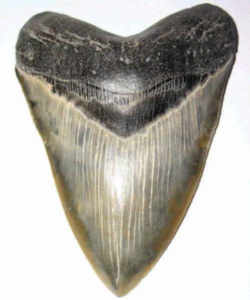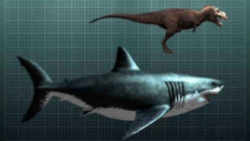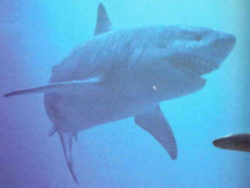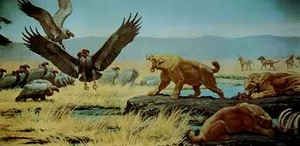
North Carolina Symbols
North Carolina State Fossil
Fossilized Teeth of the Megalodon Shark

(C. megalodon)
Adopted on June 26, 2013.
The fossilized teeth of the megalodon shark became the official state fossil of the State or North Carolina when Governor Pat McCrory signed mega-symbol House Bill No. 830 on June 26, 2013.
The follow reasons were offered: The megalodon shark is an extinct shark species that lived over 1.5 million years ago; and may have reached over 40 feet in length and weighed up to 100 tons; and had serrated, heart-shaped teeth that may have grown to over seven inches in length; and fossilized teeth of the megalodon shark have been found in North Carolina and throughout the world.
North Carolina State Fossil:
Fossilized Teeth of the Megalodon Shark
In fossil form, the shark tooth can be traced back 375,000,000 years. Fossilized shark teeth are found in a range of colors--from the more common blacks and grays to whites, browns, blues and reddish browns.

Megalodon meaning "big tooth", from Ancient Greek: (megas) "big, mighty" + (odon) (from (odous) "tooth"), is an extinct species of shark that lived approximately 28 to 1.5 million years ago, during the Cenozoic Era (late Oligocene to early Pleistocene).
The taxonomic assignment of C. megalodon has been debated for nearly a century, and is still under dispute. The two major interpretations are Carcharodon megalodon (under family Lamnidae) or Carcharocles megalodon (under family Otodontidae). Consequently, the scientific name of this species is commonly abbreviated C. megalodon in the literature.
Characteristics of the Megalodon

C. megalodon is regarded as one of the largest and most powerful predators in vertebrate history, and likely had a profound impact on the structure of marine communities. Fossil remains suggest that this giant shark reached a maximum length of 14-18 metres (46-59 ft), and also affirm that it had a cosmopolitan distribution. Scientists suggest that C. megalodon looked like a stockier version of the great white shark, Carcharodon carcharias
Since shark skeletons are composed of cartilage rather than bone, shark teeth are often the only part of a shark to fossilize and survive hundreds of millions of years. Sharks continually shed their teeth, up to tens of thousands in a lifetime, making shark tooth fossils plentiful. Approximately 2,000 species of fossil shark have been described.
Fossils mainly date from the Miocene epoch through the late Cretaceous period, making them approximately 8 to 150 million years old. Fossilized shark teeth of up to 450 million years of age have been found. Most commonly black or shades of gray, fossil shark teeth can also be white, brown, and even shades of red and blue. The minerals present in the sediment surrounding the tooth determine its color.
General Assembly of North Carolina Session 2013
SESSION LAW 2013-189
HOUSE BILL 830
AN ACT to adopt an official state fossil, frog, Salamander, marsupial, folk art, and art medium.
Whereas, some of North Carolina's official State symbols have been suggested by the State's school children after they have had history, science, social
studies, or geography lessons related to North Carolina; and
Whereas, this year some of the suggestions range from the adoption of an official fossil to an official frog; and
Whereas, the State of North Carolina has a number of unique official symbols but does not have an official fossil, frog, salamander, marsupial, folk
art, or art medium; and
Whereas, the megalodon shark is an extinct shark species that lived over 1.5 million years ago; and
Whereas, the megalodon shark may have reached over 40 feet in length and weighed up to 100 tons; and
Whereas, the megalodon shark had serrated, heart-shaped teeth that may have grown to over seven inches in length; and
Whereas, fossilized teeth of the megalodon shark have been found in North Carolina and throughout the world; and
Whereas, North Carolina and the Southeast region of the United States lead the world in amphibian diversity; and
Whereas, the pine barrens tree frog can be found in the Sandhills and Coastal Plain regions of North Carolina; and
Whereas, the pine barrens tree frog has been considered one of the most striking and beautiful frogs in the Southeast region of the United States;
and
Whereas, the pine barrens tree frog by name reflects one of North Carolina's signature trees and ecosystems that have been a vital part of the State's
economic, cultural, and natural history since colonial times; and
Whereas, North Carolina also leads the nation and world in salamander diversity, most notably in our Appalachian Mountains; and
Whereas, the marbled salamander is found throughout the State and is unique in that it is a charismatic, striking, chunky-bodied, fossorial amphibian,
of which no two are exactly alike in color pattern; and
Whereas, according the North Carolina Wildlife Commission's 2005 North Carolina Wildlife Action Plan, the pine barrens tree frog and the marbled salamander
have been identified as priority species for population monitoring and conservation in North Carolina; and
Whereas, the Virginia opossum is native to North Carolina and is the only marsupial found in North America; the female carries its underdeveloped young
in a pouch until they are capable of living independently, similar to a kangaroo; and
Whereas, the Virginia opossum is one of the oldest and most primitive species of mammal found in North America; and
Whereas, the Virginia opossum is about the size of a large house cat with a triangular head; a long pointed nose; dark eyes; a long, scaly, prehensile
tail; and short, black, leathery ears; and
Whereas, the Virginia opossum is nocturnal and lives in a wide variety of habitats, including deciduous forests, open woods, and farmland but prefers
wet areas such as marshes, swamps, and streams; and
Whereas, at age 65, Vollis Simpson, a self-taught folk artist, began making giant windmills known as "whirligigs" at his home in Wilson,
North Carolina; and
Whereas, Mr. Simpson's whirligigs have been exhibited at the North Carolina Museum of Art in Raleigh, the High Museum of Art in Atlanta, Georgia, and
the Visionary Art Museum in Baltimore, Maryland, and at other locations, including New York, California, Canada, and England; and
Whereas, Mr. Simpson and details of his artwork have been featured in many national magazines and in several books; and
Whereas, the City of Wilson is developing the Vollis Simpson Whirligig Park to display a large collection of these whirligigs in historic downtown,
which will be a one-of-a-kind destination for visitors; and
Whereas, North Carolina's clay-rich soil has contributed to the State's pottery heritage; and
Whereas, the use of clay has grown from the State's early Native Americans making mostly utilitarian wares and European settlers continuing the traditions
of their ancestors to today's potters designing pottery with utilitarian and aesthetic elements; and
Whereas, the pottery tradition continues to thrive in North Carolina, especially in the Seagrove area, which includes parts of Chatham, Lee, Moore,
Montgomery, and Randolph Counties; and
Whereas, clay continues to be an important art medium contributing to the State's cultural, social, and economic prosperity; Now, therefore,
The General Assembly of North Carolina enacts:
SECTION 1. Chapter 145 of the General Statutes is amended by adding the following new sections to read:
§ 145-41. State fossil.
The fossilized teeth of the megalodon shark is adopted as the official fossil of the State of North Carolina.
"§ 145-42. State frog.
The pine barrens tree frog (Hyla andersonii) is adopted as the official frog of the State of North Carolina.
"§ 145-43. State salamander.
The marbled salamander (Ambystoma opacum) is adopted as the official salamander of the State of North Carolina.
"§ 145-44. State marsupial.
The Virginia opossum (Didelphis virginiana) is adopted as the official marsupial of the State of North Carolina.
"§ 145-45. State folk art.
The whirligigs created by Vollis Simpson are adopted as the official folk art of the State of North Carolina.
"§ 145-46. State art medium.
Clay is adopted as the official art medium of the State of North Carolina."
SECTION 2. This act is effective when it becomes law.
In the General Assembly read three times and ratified this the 20th day of June, 2013.
s/ Philip E. Berger
President Pro Tempore of the Senate
s/ Thom Tillis
Speaker of the House of Representatives
s/ Pat McCrory
Governor
Approved 4:24 p.m. this 26th day of June, 2013
The North Carolina General Statutes
The law designating the megalodon shark as the official North Carolina state fossil is found in the North Carolina General Statutes, Chapter 145, Section 145-41.
CHAPTER 145. State Symbols and Other Official Adoptions.
SECTION 145-41.
§ 145-41. State fossil.
The fossilized teeth of the megalodon shark is adopted as the official fossil of the State of North Carolina.
Taxonomic Hierarchy: Megalodon shark
Kingdom: Animalia
Phylum: Chordata
Subphylum: Vertebrata
Class: Chondrichthyes
Subclass: Elasmobranchii
Superorder: Selachimorpha
Order: Lamniformes
Family: Lamnidae or Otodontidae
Genus: Carcharodon or Carcharocles
Species: C. megalodon
Binomial name: Carcharodon megalodon or Carcharocles megalodon

Some states that lack a "state fossil" have nevertheless singled out a fossil for formal designation such as a state dinosaur, rock, gem or stone.






